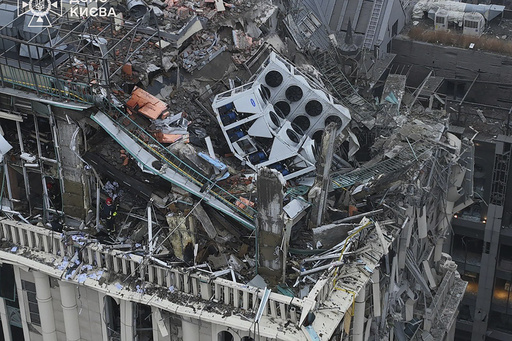KYIV, Ukraine — A Ukrainian missile assault on Friday targeted the town of Rylsk in Russia’s Kursk border area, resulting in the deaths of six individuals, including one child, according to a top official in the region. This offensive followed a Russian missile barrage on Kyiv, which claimed at least one life and injured 13 others. Moscow contended that the Kyiv attack was a retaliation for earlier Ukrainian strikes on Russian territory employing U.S.-manufactured weaponry.
Among the casualties in Rylsk, ten individuals, including a 13-year-old, were sent to hospitals after the assault involving HIMARS missiles, as reported by Kursk’s acting Governor, Alexander Khinshtein, who did not disclose further information. Russia has been endeavoring to repel Ukrainian forces that began their incursion into Kursk in early August, yet Ukrainian troops have remained entrenched.
The HIMARS launchers, which are mounted on trucks, use GPS-guided missiles capable of reaching destinations as far as 80 kilometers (approximately 50 miles) away. Due to their mobility, they pose a challenge for the enemy to locate and can rapidly reposition after firing to avoid counterattacks.
Last month, President Joe Biden approved the use of U.S.-supplied missiles by Ukraine for deeper strikes into Russian territory, relaxing previous restrictions on these longer-range weapons. This decision was a response to the deployment of thousands of North Korean soldiers by Russia to bolster its military efforts.
Early Friday morning, the city of Kyiv was shaken by at least three explosive sounds. The Ukrainian air force reported it had intercepted five short-range Iskander ballistic missiles aimed at the capital. The strikes resulted in heating outages for 630 residential structures, 16 healthcare facilities, and 30 educational institutions, as detailed by city officials. Debris from the missiles triggered damage and ignited fires across three districts.
Residents were urged by the air force to respond swiftly to reports of potential missile attacks, emphasizing the limited time available for seeking refuge. Since the onset of the conflict nearly three years ago, Russia has consistently targeted civilian regions in Ukraine, frequently intending to disrupt the power supply and instill fear among the Ukrainian populace. Meanwhile, Ukraine, facing the challenge of repelling a larger Russian military presence on the frontline, has sought to attack Russian infrastructure that contributes to the war effort.
In Kyiv, the falling missile fragments inflicted damage on around two dozen high-rise office buildings, as well as the historic St. Nicholas Catholic Church and the Kyiv National Linguistic University. Reports from the Ukrainian Foreign Ministry indicated that a blast wave, possibly from an intercepted missile, shattered windows and caused other harm to six different embassies.
Approximately five hours later, air raid sirens sounded once more, prompting Valeriia Dubova, a 32-year-old photographer, to find safety in a crowded subway station alongside others. In recounting the morning’s events, Dubova noted she had been at home when the walls began to tremble. Fire engines and ambulances could be seen rushing through the streets outside, she remarked.
On the Russian side, the Defense Ministry stated that its missile strike was a counteraction to a Ukrainian attack on the Rostov region earlier in the week. That prior assault involved six American-made Army Tactical Missile System (ATACMS) missiles combined with four Storm Shadow missiles supplied by the United Kingdom, as stated by Russian officials. Ukraine asserted the involvement of these strikes was aimed at hitting a Rostov oil refinery as part of their broader strategy to disrupt Russian logistical support for its military operations.
Ukraine’s recent use of Western-supplied weaponry against Russian targets has incensed the Kremlin. In a statement at the United Nations, Russia’s U.N. Ambassador Vassily Nebenzia criticized Ukrainian President Volodymyr Zelenskyy for his actions purportedly aimed at thwarting peace efforts while provoking further conflict with Russia.
Ukraine fired its first American-supplied long-range missiles into Russia on November 19, following an easing of restrictions by Washington. This shift also led Russia to deploy a new hypersonic missile known as Oreshnik for the first time, with President Vladimir Putin suggesting it could target governmental structures in Kyiv, although there have been no subsequent reports of its use.
In response to the Ukrainian attack on Rostov, the Russian Defense Ministry claimed to have launched a coordinated strike utilizing “high-precision, long-range weaponry” against the command center of Ukraine’s military intelligence agency, as well as another facility associated with Ukraine’s Neptune missile systems. They also asserted the targeting of Ukrainian cruise missile systems and U.S.-sourced Patriot air defense systems, concluding that all intended targets were successfully hit, although these assertions could not be independently verified.
Russian attacks continued to impact civilian areas across Ukraine, with regional authorities reporting that six individuals, including a 15-year-old girl, were injured as a result of missile strikes in Kryvyi Rih. This marked the second consecutive night of assaults in the hometown of President Zelenskyy. Additionally, Russian artillery struck the southern city of Kherson, causing extensive damage and leaving approximately 60,000 residents without electricity.
A previous version of this report was amended to clarify that Russia attributed the missile attack on Friday to a Ukrainian assault that occurred on December 18, rather than the earlier date of Friday itself.



